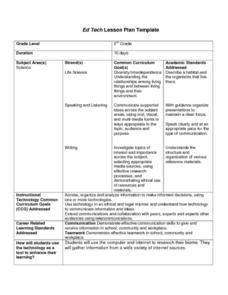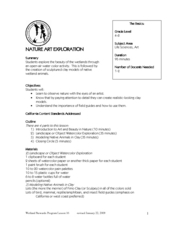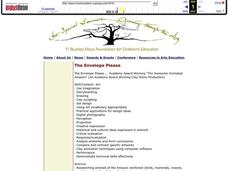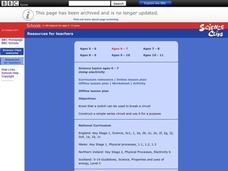Curated OER
ACTIVITY 6: MAKE A FOSSIL MOLD AND CAST and ACTIVITY 7: HOW BIG WERE PREHISTORIC ANIMALS?
Instructions for two terrific ancient history lessons for your primary paleontologists are provided in this resource. The first involves the creation of fossil cast replicas using plaster of Paris. The directions are detailed, but the...
Curated OER
Animals in Art
Second graders demonstrate visual awareness by listing seven to nine types of animals shown in the artwork on the tour. They draw three types of textured lines or patterns shown in the tour artwork and model an imaginary animal using clay.
Curated OER
Animal Adults and Babies
Students examine how different animals care for their young and how young animals change as they grow. They conduct research on the growth patterns and life cycle of a selected animal, create a realistic baby and adult form of their...
Curated OER
Close to Home
Fourth graders examine habitats for animals by creating their own in class environment. In this environment lesson, 4th graders research the Internet for information on certain wild animals and the places in which they live. Students...
Curated OER
Clay Ants: Insect Anatomy
Students examine anatomic structures in order to identify insects from other living organisms. They gain a level of comfort from anxiety when observing and handling live and pinned insects. They create clay models of an insect.
Curated OER
Animal Habitats
Students explore animal lifestyles by researching their characteristics. In this animal habitat activity, students read the story Over in the Jungle and analyze the animal illustrations in the book. Students create clay animal characters...
Staten Island Zoo
The African Savanna
Are you thinking about taking your class to the local zoo? Kids of all ages love visiting exotic animals in order to learn about biodiversity, habitat, and animal adaptations. Here is a 44-page activity guide that provides educators with...
California Academy of Science
Fish Forms
I've said it before, and I'll say it again, you can add art to any lesson plan! While little learners are discovering why fish have specific body parts such as, scales, fins, and gills, they start making three-dimensional fish forms....
Curated OER
Organisms and Habitats
Second graders investigate biomes and the plants and animals that are native to particular biomes. They participate in a class discussion, conduct Internet research on a selected biome, and create a shoebox biome using their Internet...
Curated OER
Nature Art Exploration
Students draw a nature landscape using watercolors. In this life science lesson, students share their personal experience on the beauty of nature. They create clay models of different native animals.
Curated OER
The Envelope Please
Students examine and research the importance and functions of the skeletal system in vertebrates. They construct a 10-foot geodesic dome to illustrate the importance of architectural frameworks and create a clay animation movie.
Curated OER
Snug in the Snow
Students explore how snow helps animals survive in the wild. In this animal science lesson, students review key vocabulary words and discuss types of animal adaptations. Students construct shoebox to simulate the snowy environment where...
Curated OER
The Envelope Please
Young scholars research an animal of the rainforest. They create a computerized claymation to present their research.
Curated OER
Endangered Animals in Texas
Students research endangered animal in the library and on the Internet for information on its description, habitat, forces causing its decline, and programs to help it; students create slide show about the animal that contains a clay...
Curated OER
The Big Hideout
Middle schoolers identify the types of camouflage used by animals in the desert. They work together to create their own animal creating their own type of camouflage. They determine how well the camouflage works.
Curated OER
Marshland Ecosystems
Students identify animals in ecosystem depicted on 16th Century ceramic basin and classify them as herbivores, carnivores, or omnivores based on physical characteristics and prior knowledge, determine which life forms in ecosystem are...
Curated OER
How Do Organisms Reproduce
Students examine the difference between mitosis and meiosis, and describe the steps involved in meiosis and the significance of each step. They create a diploid nucleus containing two pairs of chromosomes using clay.
Curated OER
Extra! Extra!
Learners describe how plants and animals depend on each other. They see how living and nonliving environments change over time. They identify ways in which humans have changed their environment and the effects of those changes.
Curated OER
Explore: 2nd Grade Camouflage
Second graders discuss camouflaging in animals. They create camouflaged animal artwork out of various craft and art supplies and then see how well the creation blends into an outdoor area.
Curated OER
Using Electricity
Students read The Lighthouse Keeper's Lunch to become familiar with the way a lighthouse works.In this using electricity lesson, student create lighthouses with plasticine clay and a working circuit. Students complete a worksheet on...
Curated OER
Fossil Footsteps
Fourth graders create their own dinosaur tracks using clay. In addition, 4th graders compose a story about the dinosaur / animal who created the tracks. They study photographs of dinosaur tracks before beginning.
Curated OER
Animal Habitat Dioramas
What a better way to have learners show what they know than with a diorama? Kids research an animal, its habitat, ecosystem, and environment in order to create a three-dimensional diorama. Have older children write a short paper on their...
Curated OER
Creating Animal Prints
Students investigate the habits of animals by studying their prints. In this animal life lesson, students investigate the different types of tracks left from animals by researching the Internet. Students utilize clay or Play-Doh to...
Curated OER
Hands-on Cells
Middle schoolers review the components of a cell and the differences between plant and animal cells by creating a three-dimensional model of each type of cell. In small groups, they use modeling clay and household object to construct...
Other popular searches
- Sculpting Animals in Clay
- Air Dry Clay Animals
- Fantasy Clay Animals
- Sculpture Clay Animals
- Air Dry Clay Animals
- Clay Animals Zoo
- Mythological Clay Animals
- African Clay Animals

























